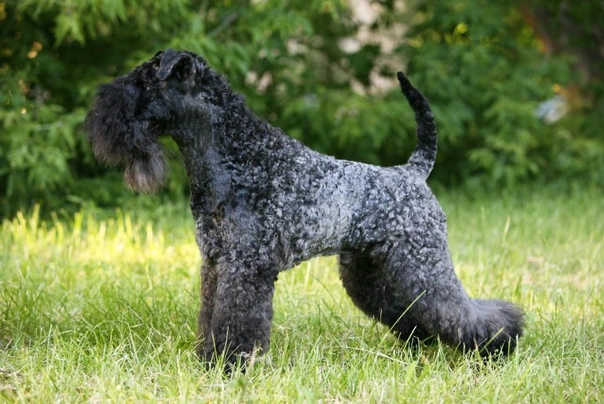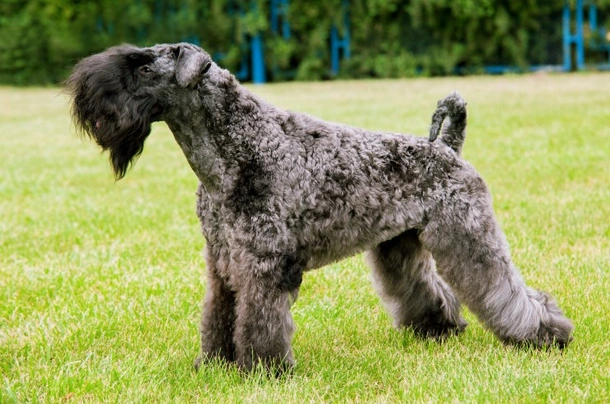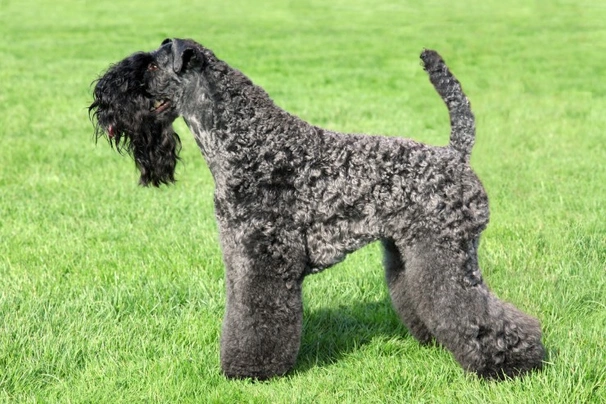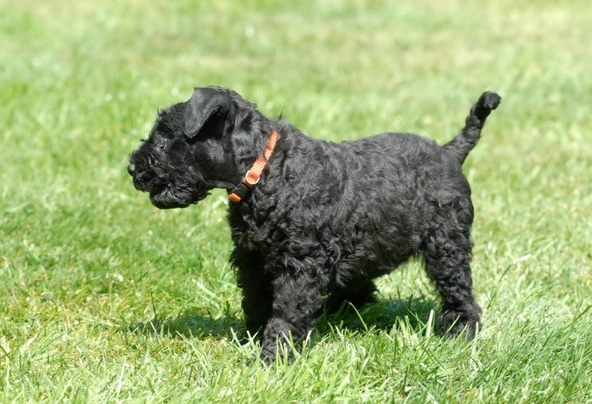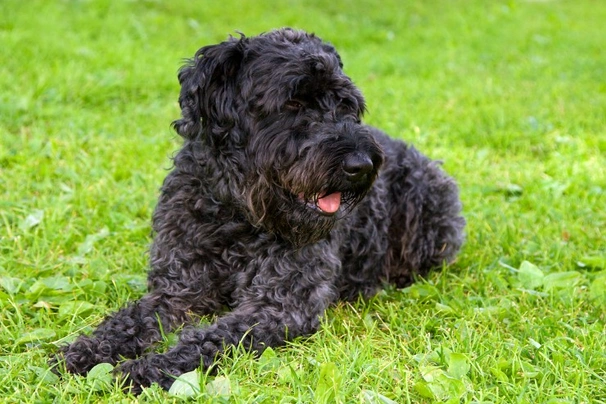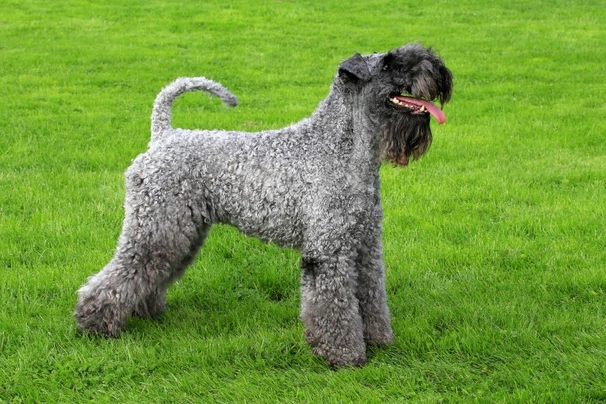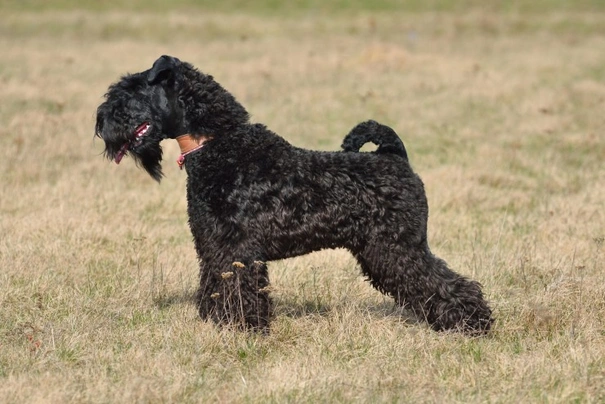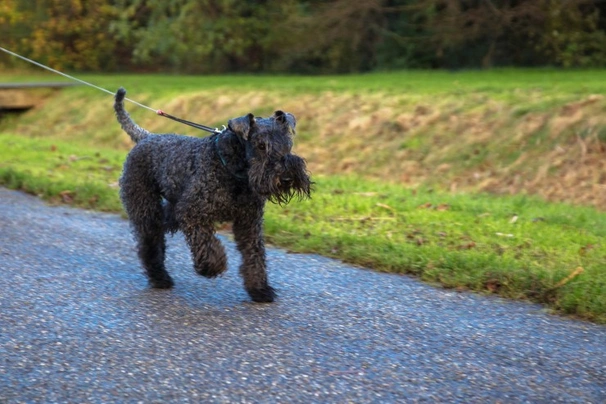Kerry Blue Terrier
Pros
Cons
Introduction of the Kerry Blue Terrier
Kerry Blue Terriers are very distinctive looking with their gorgeous astrakhan-type coats and heavily coated muzzles. Puppies are born with black coats but as they mature this changes to a lovely blue. They are compact lively yet determined dogs with all the usual terrier traits. They are better suited to people who have secure high-fenced back gardens where a dog can safely roam to their hearts delight whenever possible.
Although once a popular choice both as companion and family pet the numbers of Kerry Blue Terriers has declined over the years resulting in the breed being placed on The Kennel Club’s list of vulnerable native breeds. As such anyone wanting to share a home with a Kerry Blue would need to register their interest with breeders for the pleasure of doing so with the good news being the wait is well worth it.
History of the Kerry Blue Terrier
It is thought that the Kerry Blue Terrier may have first appeared on the scene back in the late 1800's although the breed's actual origins remain unknown. With this said enthusiasts believe that Bedlington Terriers as well as the Irish Wolfhound may well be in the breed's ancestry. There are those who believe that the Kerry Blue may well be related to the Irish Terrier and Soft Coated Wheaten Terrier too which is borne out by their resemblance. It is also thought they were bred as fighting dogs with some people believing they could be direct descendants of the Irish fighting dogs of times long past.
There is a legend that the Kerry Blue Terrier may well have been taken over to Ireland when the Spanish Armada when their ships were defeated and subsequently shipwrecked along the Irish coastline. The legend tells of a terrier-type dog being the sole survivor of a ship that went to ground off the coast of County Kerry and that the dog killed every native dog that he came across. This gained the dog a reputation and everyone wanted to own one of his puppies which in short meant this terrier became much in demand as a sire.
Another legend tells of a dog that swam ashore after a Russian ship went aground off the coast of Ireland in Tralee Bay. The dog was a Russian Blue and he mated with local Irish dogs that were around at the time. The result was the Kerry Blue Terrier. With this said Soft Coated Wheaten Terriers were around during the 18th Century and it is thought that it was a large "blue dog" that mated with a female that produced the first Kerry.
The Observer Book of Dogs that was revised in 1970 tells that the Kerry Blue Terrier is more than likely a descendant of a breed known as the "Gadher" which was used for sheep herding in ancient times and which is now extinct. No matter their ancestry the Kerry has always been a highly prized gundog in Ireland being the preferred choice over retrievers spaniels or even setters. The breed was also highly prized for their ratting abilities but also for their skills at controlling other vermin which includes badgers and foxes to name but two.
For a long time the breed was known as the Irish Blue Terrier but in England they are known as the Kerry Blue Terrier. The National Terrier of Ireland club was founded in 1927 and during the twenties the breed was gaining popularity in England. However Kerries were used to guard prison of war camps aerodromes as well as workers during the wars and subsequently breed numbers fell dangerously low. Thanks to the efforts and endeavours of breed enthusiasts however the Kerry was saved from vanishing altogether although their numbers are still relatively low even today.
With this said by the mid 1900's Kerries had become so popular they started to be shown at exhibitions and dog shows including 'Crufts'. The breed was standardised and introduced to Britain in 1922 and proved popular. However these lovely terriers have been placed on the vulnerable native breeds list by The Kennel Club with very few dogs being registered every year. As such anyone wanting to share a home with a Kerry would need to register their interest with breeders for the pleasure of doing so.
Interesting facts about the breed
- Is the Kerry Blue a vulnerable breed? Yes the breed has been placed on the Kennel Club's native vulnerable breed list and anyone wanting to share a home with a Kerry would need to register their interest with breeders because so few well-bred healthy puppies are bred and registered with the Kennel Club every year
- The Kerry was bred to be an all-rounder working on farms in Ireland which saw them herding livestock controlling vermin and guarding property and livestock. They were also used for hunting and retrieving
- During the World Wars the Kerry was used to guard aerodromes and prison camps as well as other military installations
- It was a Kerry Blue Terrier that interrupted play at the Ashes that were held at the Oval when a dog ran onto the pitch and had to be caught by one of the fast bowlers named John Lever
- Traditionally a Kerry Blue Terrier's tail was always docked but since the law banning the procedure came into effect in 2007 tail docking is now illegal with the exception being for some working breeds and if a dog suffers from some sort of health issue that requires their tails to be docked. The procedure must be agreed and authorised before being performed by a qualified vet
Appearance of the Kerry Blue Terrier
Height at the withers: Males 46 - 48 cm Females 44 - 46 cm
Average weight: Males 12 - 15 kg Females 10 - 13 kg
Puppies are born black and their coats can take up to 18 months for the colour to turn blue. They are very handsome terriers with coats that are more like astrakhan than hair and their muzzles are heavily covered which adds to their overall charming appeal. Their heads are well-balanced and long although nicely in proportion with the rest of the body. Their heads are flat on top with dogs boasting a slight stop. Their forefaces are very strong as are their jaws and noses are black. Eyes are dark and medium in size with dogs boasting a keen and very typical "terrier" expression in them. Their ears are moderately small and V-shaped which dogs carry forward. The Kerry Blue has a strong jaw with a perfect scissor bite where their upper teeth neatly overlap their lower ones and the roof of their mouths and gums are dark in colour.
Necks are strong and slope neatly into a dog's shoulders which are flat and their legs are straight showing a lot of bone. These terriers have nicely proportioned bodies with a deep brisket and well sprung ribs. Chest are deep and toplines level. They have powerful well-developed hindquarters with strong and well-muscled back legs. Feet are small and round with black nails. Tails are set high and are moderately long which adds to a dog's overall well-balanced look. It is thicker at the base but tapers neatly to the tip and dogs hold their tails straight although when excited they carry it gaily.
When it comes to their coat the Kerry Blue Terrier has a soft silky dense and wavy coat. The accepted breed colours for Kennel Club registration are as follows:
- Black
- Black & Blue
- Black Turning Blue
- Blue
Kerry Blues can have a small patch of white hair on their chests and would not be penalised for it in the show ring.
Gait/movement
When a Kerry Blue Terrier moves they do so with a powerful free-moving actions with a nice straight and parallel movement both in their front and hind legs. A dog's stifles neither turning in or out.
Faults
The Kennel Club frowns on any exaggerations or departures from the breed standard and would judge the faults on how much they affect a dog's overall health and wellbeing as well as their ability to perform.
Males should have both testicles fully descended into their scrotums and it is worth noting that a dog can be a little lighter or heavier as well as slightly taller or shorter than set out in the Kennel Club breed standard which is only given as a guideline.
Temperament of the Kerry Blue Terrier
Kerries are known to be outgoing and confident terriers. They can be strong-willed when they want to be which can make them harder to train. Male dogs in particular can be a little aggressive if they find themselves in any situations that might stress them out. They need to know their place in the "pack" and who is alpha dog in a household to prevent them from showing a more dominant side to their natures.
It's really important for Kerries to be well socialised from a young age which should include introducing them to as many new situations people dogs and other animals as soon as they are fully vaccinated as possible. They are renowned for their stamina and endurance which means these terriers need to be given lots of mental stimulation to prevent boredom from setting in. Kerries do get easily bored which can lead to them developing all sorts of unwanted behaviours and this includes being destructive around the home.
Are they a good choice for first time owners?
Kerry Blues are not the best choice for first time owners because they really do need to be handled and trained by people who are familiar with the breed or this type of strong willed and intelligent dog. The reason being that a Kerry might get the better of a novice owner thanks to their intelligence and the fact they can be so strong willed and dominant by nature.
What about prey drive?
Kerries have a high prey drive and will happily chase down anything that moves or tries to run away from them. If they spot something in the distance they are likely to be off to investigate often ignoring the recall command. As such care must be taken as to where and when a Kerry Blue Terrier can run off the lead especially if there is livestock or wildlife as well as other dogs close by.
What about playfulness?
The Kerry Blue Terrier is a fun-loving breed always alert and enthusiastic about everything that goes on around them which includes being able to play lots of interactive games with their families. They are known to be a little mischievous when the mood takes them and being so clever a Kerry quickly learns how to get their own way.
What about adaptability?
A Kerry needs to be able to roam around in a secure back garden as often as possible to really let off steam. With this said fencing needs to be high to keep a dog from jumping out. In short fences must be anything from 5 to 6-foot-high to keep a Kerry safely in. The good news is they are not known to be "diggers" bearing in mind that there always exists an exception to a rule.
What about separation anxiety?
Kerries enjoy being around people and their families they hate it when they are left to their own devices which sees them suffering from separation anxiety. This can lead to them being destructive around the home which is a dog's way of relieving any stress they are feeling and a way to keep themselves entertained. As such they are better suited to households where someone is around most of the time rather than household where everyone is typically out for large chunks of the day.
What about excessive barking?
Kerries like the sound of their own voices a little too much which is something that needs to be gently nipped in the bud when a dog is still young being careful not to frighten them. With this said it is often hard to stop a Kerry from doing what they like to do best because of the wilful and sometimes stubborn side to their natures.
Do Kerry Blue Terriers like water?
Most Kerries love swimming and will take to the water whenever they can more especially when the weather is hot. However if anyone who owns a dog that does not like water should never force them to go in because it would just end up scaring them. With this said care should always be taken when walking a Kerry Blue off the lead anywhere near more dangerous watercourses just in case a dog decides to leap in and then needs rescuing because they cannot get out of the water on their own.
Are Kerry Blue Terriers good watchdogs?
Like a lot of terrier breeds Kerries are good watchdogs because they are always on the alert and ready to let an owner know when something they don't like is going on around them and when there are strangers about. However they are not good "guard" dogs thanks mainly to their social natures and their size. With this said rarely would a Kerry show any sort of aggressive behaviour towards a stranger unless they felt threatened that is. In short they are known to be keen watchdogs and because they like to voice an opinion they are quick off the mark when people they don't know are about.
Intelligence / Trainability of the Kerry Blue Terrier
Kerry Blue Terriers are known to be intelligent they are also very outgoing and confident characters which means they need to be handled and trained with a firm fair and gentle hand to get the best results. They do not answer well to any sort of harsh correction or heavy-handed training but they do respond very well to positive reinforcement but because they are so intelligent these terriers must not be allowed to pick up any bad habits which they can learn as fast as they learn the "good" things. These little dogs are never happier than when they know their place in the pack and who to look up to for direction and guidance.
Kerry puppies like all puppies are incredibly cute and it is all too easy to spoil them when they first arrive in their new homes. However owners must start out as they mean to go on which means that as soon as a puppy is settled they must be taught the rules and boundaries so they understand what is expected of them. It also helps establish a pecking order and who is the alpha dog in a household bearing in mind that Kerries are alert and smart which means they pick new things up quickly this includes the good and the bad. The first commands a puppy should be taught are as follows:
- Come
- Sit
- Stay
- Heel
- Quiet
- Leave it
- Down
- Bed
Children and other
The Kerry Blue is a great choice as a family pet where the children in a household are older and therefore know how to behave around dogs. They are not the best choice for people with toddlers or small children because Kerries can be a little boisterous at times which could result in them knocking a child over and scaring them.
Care should be taken when Kerries are around small pets and other animals because of their high prey drive therefore any contact should really be avoided and this includes when they are around cats. They can be aggressive when they meet other dogs with Kerries often wanting to play a little too boisterously with them.
Health of the Kerry Blue Terrier
The average life expectancy of a Kerry Blue Terrier is between 12 and 15 years when properly cared for and fed an appropriate good quality diet to suit their ages.
Like so many other breeds the Kerry is known to suffer from a few hereditary health issues which are worth knowing about if you are planning share your home with one of these active and good-looking dogs. The conditions that seem to affect the breed the most include the following:
- Hip dysplasia - dogs should be hip scored with the breed mean score standing at 13.6 although parent dogs should be lower than this
- Elbow dysplasia - dogs should be tested and the ideal score should be 0:0
- Cataracts
- Entropion
- Dry eye
- Skin problems
- Cysts
- Other issues - mainly caused by hair falling in a dog's eyes and excess hair in their ears which leads to a buildup of wax and subsequently possible ear infections
It is worth noting that the Kennel Club breed average coefficient for the breed stands at 13.2%.
What about vaccinations?
Kerry Blue puppies would have been given their initial vaccinations before being sold but it is up to their new owners to make sure they have their follow-up shots in a timely manner with the vaccination schedule for puppies being as follows:
- 10 -12 weeks old bearing in mind that a puppy would not have full protection straight away but would be fully protected 2 weeks after they have had their second vaccination
There has been a lot of discussion about the need for dogs to have boosters. As such it's best to talk to a vet before making a final decision on whether a dog should continue to have annual vaccinations which are known as boosters.
What about spaying and neutering?
A lot of vets these days recommend waiting until dogs are slightly older before spaying and neutering them which means they are more mature before undergoing the procedures. As such they advise neutering males and spaying females when they are between the ages of 6 to 9 months old and sometimes even when a dog is 12 months old.
Other vets recommend spaying and neutering dogs when they are 6 months old but never any earlier unless for medical reasons. With this said many breeds are different and it is always advisable to discuss things with a vet and then follow their advice on when a dog should be spayed or neutered.
What about obesity problems?
Like other breeds Kerries can gain weight after they have been spayed or neutered and it's important to keep an eye on a dog's waistline just in case they do. If a dog starts to put on weight it's important to adjust their daily calorie intake and to up the amount of exercise they are given. Older dogs too are more prone to gaining weight and again it's essential they be fed and exercised accordingly because obesity can shorten a dog's life by several years. The reason being that it puts a lot of extra strain on a dog's internal organs including the heart which could prove fatal.
What about allergies?
Kerries are prone to suffering from allergies and skin issues and it's important for a dog to see a vet sooner rather than later if one flares up. Allergies can be notoriously hard to clear up and finding the triggers can be challenging. With this said a vet would be able to make a dog with an allergy more comfortable while they try to find out the triggers which could include the following:
- Certain dog foods that contain high levels of cereal and other grain-type fillers
- Airborne pollens
- Dust mites
- Environment
- Flea and tick bites
- Chemicals found in everyday household cleaning products
Participating in health schemes
All responsible Kerry Blue Terrier breeders would ensure that their stud dogs are tested for known hereditary and congenital health issues known to affect the breed by using the following schemes:
- Von Willebrand’s Disease (vWD) Type 1
- Von Willebrand’s Disease (vWD) Type 3
- Factor X1 deficiency
- Canine Multiple System Degeneration (CMSD)
What about breed specific breeding restrictions?
Apart from the standard breeding restrictions set in place for all Kennel Club registered breeds there are no other breed specific breeding restrictions in place for the Kerry Blue Terrier.
What about Assured Breeder Requirements?
Currently there are no Kennel Club Assured Breeder requirements for the Kerry Blue Terrier.
Caring for the Kerry Blue Terrier
As with any other breed Kerries need to be groomed on a regular basis to make sure their coats and skin are kept in top condition. They also need to be given regular daily exercise to ensure they remain fit and healthy. On top of this dogs need to be fed good quality food that meets all their nutritional needs throughout their lives.
Caring for a Kerry Blue Terrier puppy
Kerry puppies are boisterous and full of life which means it's essential for homes and gardens to be puppy-proofed well in advance of their arrival. A responsible breeder would have well socialised their puppies which always leads to more outgoing confident and friendly dogs right from the word go. With this said any puppy is going to feel vulnerable when they leave their mother and littermates which must be taken into account. The longer a puppy can remain with their mother the better although it should never be for too long either.
It's best to pick a puppy up when people are going to be around for the first week or so which is the time needed for a puppy to settle in. Puppy-proofing the home and garden means putting away any tools and other implements that a boisterous puppy might injure themselves on. Electric wires and cables must be put out of their reach because puppies love chewing on things. Toxic plants should be removed from flowerbeds and the home too.
Puppies need to sleep a lot to grow and develop as they should which means setting up a quiet area that's not too out of the way means they can retreat to it when they want to nap and it's important not to disturb them when they are sleeping. It's also a good idea to keep "playtime" nice and calm inside the house and to have a more active "playtime" outside in the garden which means puppies quickly learn to be less boisterous when they are inside.
The documentation a breeder provides for a puppy must have all the details of their worming date and the product used as well as the information relating to their microchip. It is essential for puppies to be wormed again keeping to a schedule which is as follows:
- Puppies should be wormed at 6 months old
- They need to be wormed again when they are 8 months old
- Puppies should be wormed when they are 10 months old
- They need to be wormed when they are 12 months old
Things you'll need for your puppy
There are certain items that new owners need to already have in the home prior to bringing a new puppy home. It's often a good idea to restrict how much space a puppy plays in more especially when you can't keep an eye on what they get up to bearing in mind that puppies are often quite boisterous which means investing in puppy gates or a large enough playpen that allows a puppy the room to express themselves while keeping them safe too. The items needed are therefore as follows:
- Good quality puppy or baby gates to fit on doors
- A good well-made playpen that's large enough for a puppy to play in so they can really express themselves as puppies like to do
- Lots of well-made toys which must include good quality chews suitable for puppies to gnaw on bearing in mind that a puppy will start teething anything from when they are 3 to 8 months old
- Good quality feed and water bowls which ideally should be ceramic rather than plastic or metal
- A grooming glove
- A slicker brush or soft bristle brush
- Dog specific toothpaste and a toothbrush
- Scissors with rounded ends
- Nail clippers
- Puppy shampoo and conditioner which must be specifically formulated for use on dogs
- A well-made dog collar or harness
- A couple of strong dog leads
- A well-made dog bed that's not too small or too big
- A well-made dog crate for use in the car and in the home that's large enough for a puppy to move around in
- Baby blankets to put in your puppy's crate and in their beds for when they want to nap or go to sleep at night
Keeping the noise down
All puppies are sensitive to noise including Kerry Blue Terriers puppies. It's important to keep the noise levels down when a new puppy arrives in the home. TVs and music should not be played too loud which could end up stressing a small puppy out which could end up making them timid and shy instead of outgoing and confident.
Keeping vet appointments
As previously mentioned Kerry puppies would have been given their first vaccinations by the breeders but they must have their follow up shots which is up to their new owners to organise. The vaccination schedule for puppies is as follows:
- 10 -12 weeks old bearing in mind that a puppy would not have full protection straight away but would only be fully protected 2 weeks after they have had their second vaccination
When it comes to boosters it's best to discuss these with a vet because there is a lot of debate about whether a dog really needs them after a certain time. However if a dog ever needed to go into kennels their vaccinations would need to be fully up to date.
What about older Kerry Blue Terriers when they reach their senior years?
Older Kerries need lots of special care because as they reach their golden years they are more at risk of developing certain health concerns. Physically a dog's muzzle may start to go grey but there will be other noticeable changes too which includes the following:
- Coats become coarser
- A loss of muscle tone
- Kerries can either become overweight or underweight
- They have reduced strength and stamina
- Older dogs have difficulty regulating their body temperature
- They often develop arthritis
Immune systems do not work as efficiently as they once did which means dogs are more susceptible to infections
Older dogs change mentally too which means their response time tends to be slower as such they develop the following:
- They respond less to external stimuli due to impaired vision or hearing
- They tend to be a little pickier about their food
- They have a lower pain threshold
- Become intolerant of any change
- Often an older dog can feel disorientated
Living with a Kerry in their golden years means taking on a few more responsibilities but these are easily managed and should include taking a look at their diet the amount of exercise they are given how often their dog beds need changing and keeping an eye on the condition of their teeth.
Older Kerry Blue Terriers need to be fed a good quality diet that meets their needs at this stage of their lives all the while keeping a close eye on a dog's weight. A rough feeding guide for older dogs is as follows bearing in mind they should be fed highly digestible food that does not contain any additives:
- Protein content should be anything from 14 – 21%
- Fat content should be less than 10%
- Fibre content should be less than 4%
- Calcium content should be 0.5 – 0.8%
- Phosphorous content should be 0.4 – 0.7%
- Sodium content should be 0.2 – 0.4%
Older Kerries don't need to be given the same amount of daily exercise as a younger dog but they still need the right amount of physical activity to maintain muscle tone and to prevent a dog from putting on too much weight. All dogs need access to fresh clean water and this is especially true of older dogs when they reach their golden years because they are more at risk of developing kidney disorders.
Grooming of the Kerry Blue Terrier
Kerries are high maintenance in the grooming department and ideally their coats need a daily brush paying particular attention to the hair around a dog's muzzle which tends to get quite dirty after a dog has eaten. They do not shed like many other breeds but their coats need to be clipped or scissored every 6 to 8 weeks to keep things tidy. The hair between a dog's pads needs to be checked on a regular basis and trimmed if it is too long.
It's also important to check a dog's ears on a regular basis and to clean them when necessary. If too much wax builds up in a dog's ears it can lead to a painful infection which can be hard to clear up bearing in mind that this is a real problem in the breed that should never be ignored. In short prevention is often easier than cure when it comes to ear infections.
Exercise of the Kerry Blue Terrier
Kerry Blues are high energy terriers and as such they need to be given the right amount of daily exercise and mental stimulation for them to be truly happy well-rounded characters. Without the right levels of exercise they can quickly develop some unwanted behaviours around the home which includes separation anxiety. As such a minimum of one hour's exercise is essential but more would be better because it is hard to tire these terriers out.
A shorter walk in the morning would be fine but a longer more interesting one in the afternoon is a must. These dogs also like to be able to roam around a back garden as often as possible so they can really let off steam. However the fencing must be extremely secure to keep these lively dogs in because if they find a weakness in the fence they will soon escape out and get into all sorts of trouble.
With this said Kerry Blue Terrier puppies should not be given too much exercise because their joints and bones are still growing and too much pressure on them could result in causing a dog a few problems later in their lives. They should not be allowed to jump up or off furniture nor should they be allowed to run up and down the stairs because this puts too much pressure on their still growing joints and limbs.
Feeding of the Kerry Blue Terrier
If you get a Kerry Blue Terrier puppy from a breeder they would give you a feeding schedule and it's important to stick to the same routine feeding the same puppy food to avoid any tummy upsets. You can change a puppy's diet but this needs to be done very gradually always making sure they don't develop any digestive upsets and if they do it's best to put them back on their original diet and to discuss things with the vet before attempting to change it again.
Older dogs are not known to be fussy or finicky eaters but this does not mean you can feed them a lower quality diet. It's best to feed a mature dog twice a day once in the morning and then again in the evening making sure it's good quality food that meets all their nutritional requirements. It's also important that dogs be given the right amount of exercise so they burn off any excess calories or they might gain too much weight which can lead to all sorts of health issues. Obesity can shorten a dog's life by several years so it's important to keep an eye on their waistline from the word go.
Feeding guide for a Kerry Blue Terrier puppy
Puppies need to be fed a highly nutritious good quality diet for them to develop and grow as they should. As a rough guide a Kerry puppy can be fed the following amounts every day making sure their meals are evenly spread out throughout the day and it's best to feed them 3 or 4 times a day:
- 2 months old - 141g to 201g depending on puppy's build
- 3 months old - 162g to 223g depending on puppy's build
- 4 months old - 171g to 249g depending on puppy's build
- 5 months old - 173g to 253g depending on puppy's build
- 6 months old - 172g to 253g depending on puppy's build
- 7 months old - 158g to 236g depending on puppy's build
- 9 months old - 130g to 204g depending on puppy's build
Once a puppy is 11 months old they can be fed adult dog food.
Feeding guide for an adult Kerry Blue Terrier
Once fully mature an adult Kerry Blue must be fed a good quality diet to ensure their continued good health. As a rough guide an adult Kerry should be fed the following amounts every day:
- Dogs weighing 10 kg can be fed 132g to 152g depending on activity
- Dogs weighing 12 kg can be fed 151g to 175g depending on activity
- Dogs weighing 13 kg can be fed 160g to 181g depending on activity
- Dogs weighing 15 kg can be fed 169g to 196g depending on activity
Kerry Blue Terrier price
If you are looking to buy a Kerry Blue Terrier you may have to go on a waiting list because not many puppies are registered with The Kennel Club every year. You would need to pay anything from £400 to over £900 for a well-bred pedigree puppy. The cost of insuring a male 3-year-old Kerry Blue Terrier in northern England would be £21.43 a month for basic cover but for a lifetime policy this would set you back £52.65 a month (quote as of February 2018). When insurance companies calculate a pet's premium they factor in several things which includes where you live in the UK and a dog's age and whether they have been neutered or spayed among other things.
When it comes to food costs you need to buy the best quality food whether wet or dry to feed your dog throughout their lives making sure it suits the different stages of their lives. This would set you back between £30 - £40 a month. On top of this you would need to factor in veterinary costs if you want to share your home with a Kerry and this includes their initial vaccinations their annual boosters the cost of neutering or spaying your dog when the time is right and their yearly health checks all of which quickly adds up to over a £900 a year.
As a rough guide the average cost to keep and care for a Kerry Blue Terrier would be between £30 to £40 a month depending on the level of insurance cover you opt to buy for your dog but this does not include the initial cost of buying a healthy well-bred Kennel Club registered pedigree Kerry Blue Terrier puppy.
Buying advice
When visiting and buying any puppy or dog there are many important things to consider and questions to ask of the breeder/seller. You can read our generic puppy/dog advice here which includes making sure you see the puppy with its mother and to verify that the dog has been wormed and microchipped.
Kerry Blue Terriers are a popular breed both in the UK and elsewhere in the world which means that well-bred Kennel Club registered puppies can often command a lot of money. As such with Kerries there is specific advice questions and protocols to follow when buying a puppy which are as follows:
- Beware of online scams and how to avoid them. You may see online and other adverts by scammers showing images of beautiful Kerry Blue Terrierpuppies for sale at very low prices. However the sellers ask buyers for money up front before agreeing to deliver a puppy to a new home. Potential buyers should never buy a puppy unseen and should never pay a deposit or any other money online to a seller. You should always visit the pet at the sellers home to confirm they are genuine and make a note of their address.
- As previously touched upon Kerries have a large fanbase but few well-bred Kennel Club registered puppies are bred every year. As such there are many amateur breeders/people who breed from a dam far too often so they can make a quick profit without caring for the welfare of the puppies their dam or the breed in general. Under Kennel Club rules a dam can only produce 4 litters and she must be between a certain age to do so. Anyone wishing to buy a Kerry Blue Terrier puppy should think very carefully about who they purchase their puppy from and should always ask to see the relevant paperwork pertaining to a puppy's lineage their vaccinations and their microchipping.
- Prospective owners should always ask breeders if they insure puppies to cover veterinary costs as well as loss which is set in place and which last for a few weeks once they have been sold to their new owners.
- Traditionally a Kerry Blue terrier's tail was always docked but since the law banning the procedure came into effect in 2007 tail docking is now illegal with the exception being for some working breeds and if a dog suffers from some sort of health issue that requires their tails to be docked. The procedure must be agreed and authorised before being performed by a qualified vet and anyone owning a puppy or dog with a docked tail is liable to a hefty fine if the right permissions were not granted.

